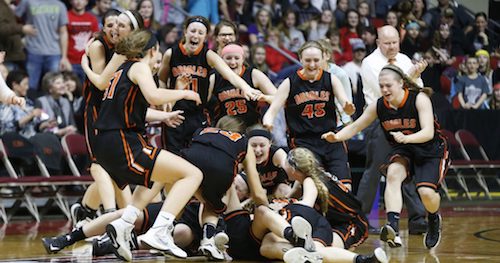When I was a kid, my parents taught me to avoid those bad four letter words we all have heard. You know the ones I mean, the ones that you would first hear in school and then think it was OK to use them at home, until you saw that look on dad’s face! My siblings and I learned pretty quickly that some four letter words were bad, and to be avoided at all times.
In youth sports these days, there is a new four letter word in the mind’s of some competitive sports folks. It is F-U-N. The mere thought that sports can be competitive AND fun makes some people shudder, but it should not.
One of our readers recently shared a story with me about attending a 10 year old AYSO youth soccer game in New York City. After watching the players struggle for a while, he asked a parent of one of the participants “how often do you practice?”
The response: “We don’t practice. Here we don’t play for competition; we just want the kids to have fun.”
I find this very sad. Not the fun part, because of course we want our kids to have fun. What is sad is the idea that competition, learning and fun cannot coexist.
Somehow the negative aspects of hyper-competitive sports – the over the top parents and coaches, excessive costs and commitments, and the often stressful environment – have created a counter culture in sports that has gone so far in the opposite direction that it is not serving the kids either. This is the trophies for everyone crowd, the people who give everyone awards for simply showing up and doing the bare minimum, or do not think kids should keep score (even though they do, but then forget about it as soon as they find out what the post game snack is). Grrr.
As our reader asked me when sharing this story: “Why do we think that it has to be one or the other? Why do we only associate excellence or competence with the negative aspects of competition? How do we communicate to parents who correctly identify the negative aspects of early competitive play: yelling coaches and parents, short term goals over long-term development, anxiety and pressure of tournaments, etc, that an environment that does not promote competence ultimately undermines the joy of learning and playing well?”
In other words, why is “fun” a four letter word in competitive sports? Why is the concept of competition an anathema in recreational sports. Can’t competitive sports also be fun, and recreational sports provide a great learning environment?
The answer is a resounding yes.
Unfortunately, this answer is in direct contradiction to what some people might call “conventional youth sports wisdom.” Such conventional wisdom states that a “competitive” youth sports experience is supposed to happen at the expense of an “enjoyable” one.
The problem is that such wisdom, especially when combined with the push to specialize early, the emphasis on winning over development, the mythology surrounding 10,000 Hours of deliberate practice, and the unrealistic pursuit of scholarships, is very hard to combat. It has become the status quo, not to be argued nor questioned, regardless of any science showing otherwise.
To illustrate how difficult it is to combat conventional wisdom thinking, may I present the case of RICE: Rest, Ice, Compression and Elevation for a sprain or muscle strain. Most people have heard this acronym. Everyone has been told RICE is the way to deal with sprains and strains since we were kids; its easy to remember, and easy to do on your own and at home. Yet there is increasing evidence that it is completely wrong, and that it actually inhibits healing. (CLICK HERE FOR A LINK TO THIS EVIDENCE) Even Dr. Gabe Mirkin, who coined the term RICE in 1978, has recently come out against it, and said he may have been wrong. New studies show that while ice helps with pain control, it prevents inflammation, and thus delays healing. Yet look up nearly any major sporting website, Wikipedia, you name it, and there it is, RICE as the recommended remedy for sprains and strains. It is hard to change conventional wisdom!
We face the same problem trying to convince parents and coaches that competition, learning and enjoyment actually belong together!
As I have written before, top sports scientists tell us that children need three things to become high-performers: autonomy, intrinsic motivation and enjoyment. The enjoyment part is so often lost in the shuffle of private coaching, year round commitments, and early specialization. Yet enjoyment is absolutely crucial.
In fact, I would go so far as to say that unless your child’s desire to play and enjoyment of play matches the effort needed to succeed, he or she will never make the commitment necessary to get to the next level.
The problem is that we now equate enjoyment with not trying our best, and this is wrong. Athletes who are enjoying themselves naturally try harder. Elite athletes love to play. This enjoyment and passion did not start when they went to college or the pros; it has been there since day one. As Lionel Messi states in this video, “I didn’t compare myself to anyone. I just enjoyed playing.”
The problem is conventional wisdom tells us that having fun in training will not develop competence. Yet science tells us that when children have fun doing something, they will do it longer. They will do it more often, outside of practice as well as during practice. By default, they will develop more competence and confidence!
 The best coaches know this. Unfortunately, many of them feel pressured to make the “best” use of valuable ice time or field rental time. They say “sorry, no scrimmages, no friendly games, we need more drills and repetitive exercises to get ready for our next competition” This makes the parents happy. This makes coaches the center of attention of training. Yet it does not fully serve the needs of the most important participants, the kids!
The best coaches know this. Unfortunately, many of them feel pressured to make the “best” use of valuable ice time or field rental time. They say “sorry, no scrimmages, no friendly games, we need more drills and repetitive exercises to get ready for our next competition” This makes the parents happy. This makes coaches the center of attention of training. Yet it does not fully serve the needs of the most important participants, the kids!
You see, game like conditions recreated in training are actually far better in preparing players for actual games, as are small sided games and scrimmages. They replicate the situations, decisions, patterns and speed of actual matches, which rarely happens in unopposed, repetitive drilling activities. Sure, a kid can pass to this line and run to that one, but can he play the right pass to the right side of his teammate at the right speed to tell his teammates where to turn, where the pressure is, and where the next pass should go? Can he do that with pressure coming from behind him, from in front, against multiple defenders? Can he show up in the right space at the right time, or just run to a cone because that is what his coach taught him to do? Only the game teaches the subtleties of the actual game.
We have far too many training environments that are too coach centric. Convention wisdom tells parents to look for these environments, with the domineering coach, constantly shouting instructions and solving problems, laying out dozens of cones, and clearly in charge. These coaches make all the decisions, and tell players where to go, when to go, and why to go. The game no longer belongs to kids. Kids do not get to make game like decisions in practice, and play fearful of making mistakes and incurring the coach’s wrath. Then game time comes along, and we wonder why the kids cannot figure it out for themselves! Couple this with the pressure to get a result, or advance in a tournament, and pretty soon kids are not improving during competition, they are getting worse, They are getting scared. And they are no longer enjoying themselves.
Learning can definitely happen without fun.
Enjoyment can definitely take place in the absence of learning.
And competition can both promote or stifle both enjoyment and education.
To truly take an athlete’s game to the next level, though, you need the coexistence of learning, enjoyment and competition, not an absence of them.
First and foremost you need fun, to keep the athlete motivated and coming back. You need learning – the development of competence – to promote improvement, confidence, and control of the experience. And you need competition to test these skills from time to time in an environment that makes mistakes likely, and thus promotes the opportunity to learn.
FUN is NOT a 4-Letter word. It can and should become the foundation of every athletic experience for kids. And when combined with learning and the right type of competitive environment, you have the ideal place to develop athletes who perform up to their potential.
Pass this along and help us change the conventional wisdom. Leave your thoughts and comments below so we can figure out together how we can accomplish this. Lets put the “PLAY” back in playing youth sports!













Comments